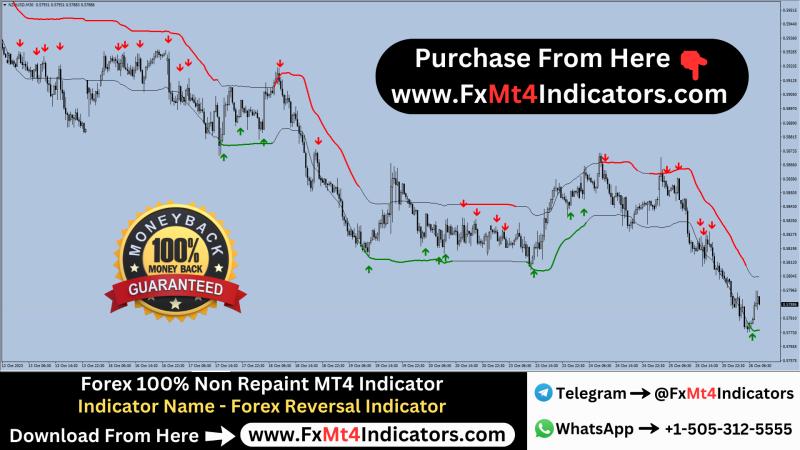MT4 forex indicators list

Here’s a comprehensive list of MT4 forex indicators, categorized by their functions. This guide provides detailed explanations of the most commonly used indicators in MetaTrader 4 (MT4), their applications, and how traders can use them to enhance their forex trading strategies.
Purchase this Powerful Indicator from here ?
Purchase Link - https://forexprostore.com/product/forex-reversal-indicator/
Contact Telegram - https://telegram.me/SecretOfFx
Contact WhatsApp - https://wa.me/+15053125555
MT4 Forex Indicators: A Comprehensive Guide
MetaTrader 4 (MT4) is one of the most widely used trading platforms for forex traders. It offers a variety of technical indicators that help traders analyze price movements, identify trends, and make informed decisions. Below is a detailed list of MT4 forex indicators, categorized based on their purpose and usage.
1. Trend Indicators
Trend indicators help traders determine the direction of the market, whether it is moving up, down, or sideways.
1.1 Moving Averages (MA)
- Simple Moving Average (SMA): Averages past prices over a set period to smooth price fluctuations.
- Exponential Moving Average (EMA): Similar to SMA but gives more weight to recent prices, making it more responsive.
- Weighted Moving Average (WMA): Assigns different weights to prices, focusing more on recent movements.
- Hull Moving Average (HMA): A smoother moving average that reduces lag and responds to price changes faster.
1.2 Moving Average Convergence Divergence (MACD)
- A combination of moving averages that helps identify trend direction and strength.
- Includes a MACD line, signal line, and histogram.
1.3 Average Directional Index (ADX)
- Measures trend strength but does not indicate direction.
- Readings above 25 suggest a strong trend; readings below 20 suggest a weak trend.
1.4 Parabolic SAR
- A trend-following indicator that places dots above or below price candles.
- Dots below price indicate an uptrend, while dots above price indicate a downtrend.
1.5 Ichimoku Kinko Hyo
- A comprehensive indicator that identifies trend direction, support/resistance, and momentum.
- Components: Tenkan-sen, Kijun-sen, Senkou Span A, Senkou Span B, and Chikou Span.
2. Momentum Indicators
Momentum indicators measure the speed at which prices change and help traders identify overbought or oversold conditions.
2.1 Relative Strength Index (RSI)
- Measures price momentum on a scale of 0-100.
- Above 70: Overbought condition (possible reversal).
- Below 30: Oversold condition (possible upward correction).
2.2 Stochastic Oscillator
- Compares a security’s closing price to its price range over a set period.
- Above 80: Overbought; Below 20: Oversold.
- Consists of two lines: %K (fast) and %D (slow).
2.3 Commodity Channel Index (CCI)
- Identifies cyclical trends and deviations from the average price.
- Readings above +100 indicate strong bullish momentum, and readings below -100 indicate bearish momentum.
2.4 Rate of Change (ROC)
- Measures the percentage change in price over a set period.
- Positive values suggest strong momentum; negative values indicate weakness.
2.5 Momentum Indicator
- Compares current closing prices to past closing prices to detect strength in price movement.
3. Volatility Indicators
Volatility indicators measure price fluctuations and help traders predict potential breakouts.
3.1 Bollinger Bands
- Composed of a middle SMA and two standard deviation bands.
- Price movements outside the bands indicate increased volatility.
3.2 Average True Range (ATR)
- Measures market volatility by averaging the true range over a period.
- A higher ATR value indicates a more volatile market.
3.3 Standard Deviation
- Measures price dispersion from the mean, indicating volatility.
4. Volume Indicators
Volume indicators help traders assess the strength of a price move by analyzing the trading volume.
4.1 On-Balance Volume (OBV)
- Uses volume to confirm trends.
- Rising OBV suggests buying pressure; falling OBV suggests selling pressure.
4.2 Money Flow Index (MFI)
- Similar to RSI but incorporates volume.
- Values above 80 indicate overbought conditions, while values below 20 indicate oversold conditions.
4.3 Accumulation/Distribution Line (A/D Line)
- Measures the cumulative flow of money into or out of a security.
- Helps identify divergence between price and volume.
5. Support and Resistance Indicators
These indicators help traders find key price levels where reversals or breakouts might occur.
5.1 Pivot Points
- Calculates potential support and resistance levels based on the previous day’s high, low, and close prices.
5.2 Fibonacci Retracement
- Identifies potential price reversal levels using Fibonacci ratios (23.6%, 38.2%, 50%, 61.8%, 78.6%).
5.3 Murrey Math Lines
- Similar to Fibonacci retracement but based on geometric principles.
5.4 Camarilla Pivots
- An alternative to standard pivot points, often used for intraday trading.
6. Custom and Advanced Indicators
Many traders develop custom indicators or use advanced ones to gain deeper insights.
6.1 Fractals
- Identifies potential reversal points based on market patterns.
6.2 Gann Indicators
- Uses angles and geometric calculations to predict price movements.
6.3 Keltner Channel
- Uses moving averages and ATR to create volatility-based channels.
6.4 Donchian Channels
- Displays the highest and lowest price levels over a given period.
6.5 Renko Charts
- Filters out market noise by focusing solely on price movements.
7. Multi-Indicator Strategies
Traders often combine multiple indicators for better accuracy.
7.1 MACD + RSI
- MACD confirms trends, while RSI identifies overbought/oversold conditions.
7.2 Bollinger Bands + Stochastic
- Bollinger Bands highlight volatility, while Stochastic confirms entry points.
7.3 Moving Averages + ADX
- Moving averages indicate direction, and ADX confirms trend strength.
8. Custom MT4 Indicators and Expert Advisors (EAs)
8.1 Custom Indicators
- Traders can program their own indicators using MQL4 to create custom strategies.
8.2 Expert Advisors (EAs)
- Automated trading algorithms based on indicator signals.
- Can execute trades without human intervention based on predefined rules.
Conclusion
MT4 provides a wide range of indicators that help forex traders analyze price trends, momentum, volatility, and volume. Understanding these indicators and how to use them effectively can improve trading strategies and decision-making. Whether focusing on trend analysis, market momentum, volatility assessment, or support and resistance levels, MT4 indicators offer traders the necessary tools to navigate the forex market successfully.
Post Your Ad Here
Comments